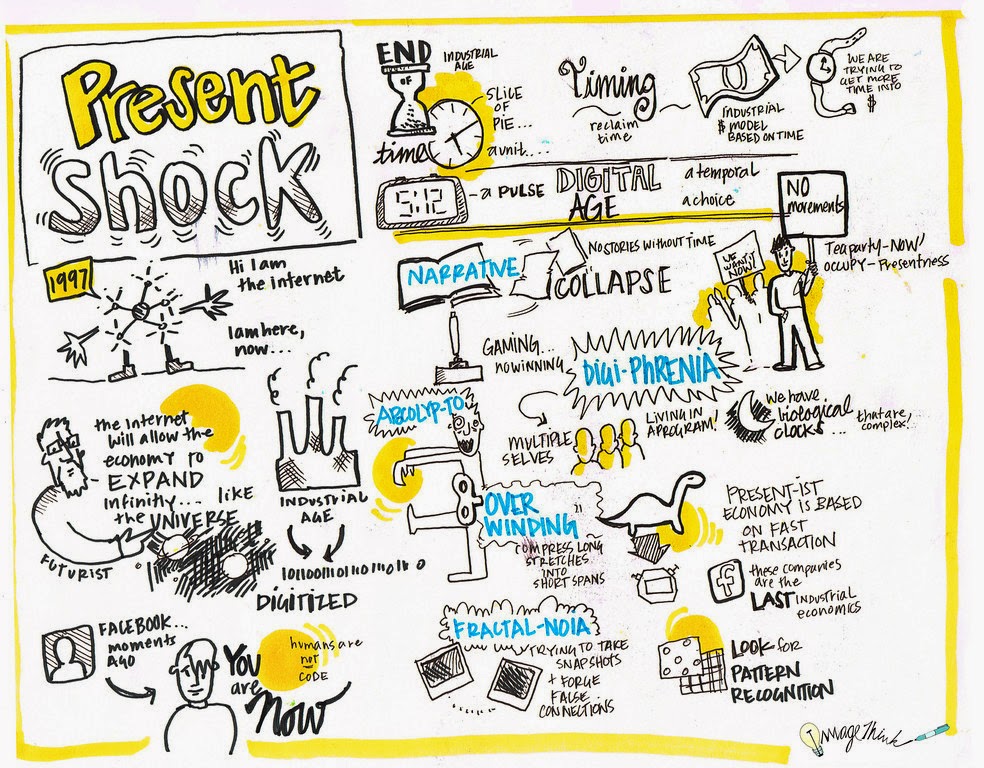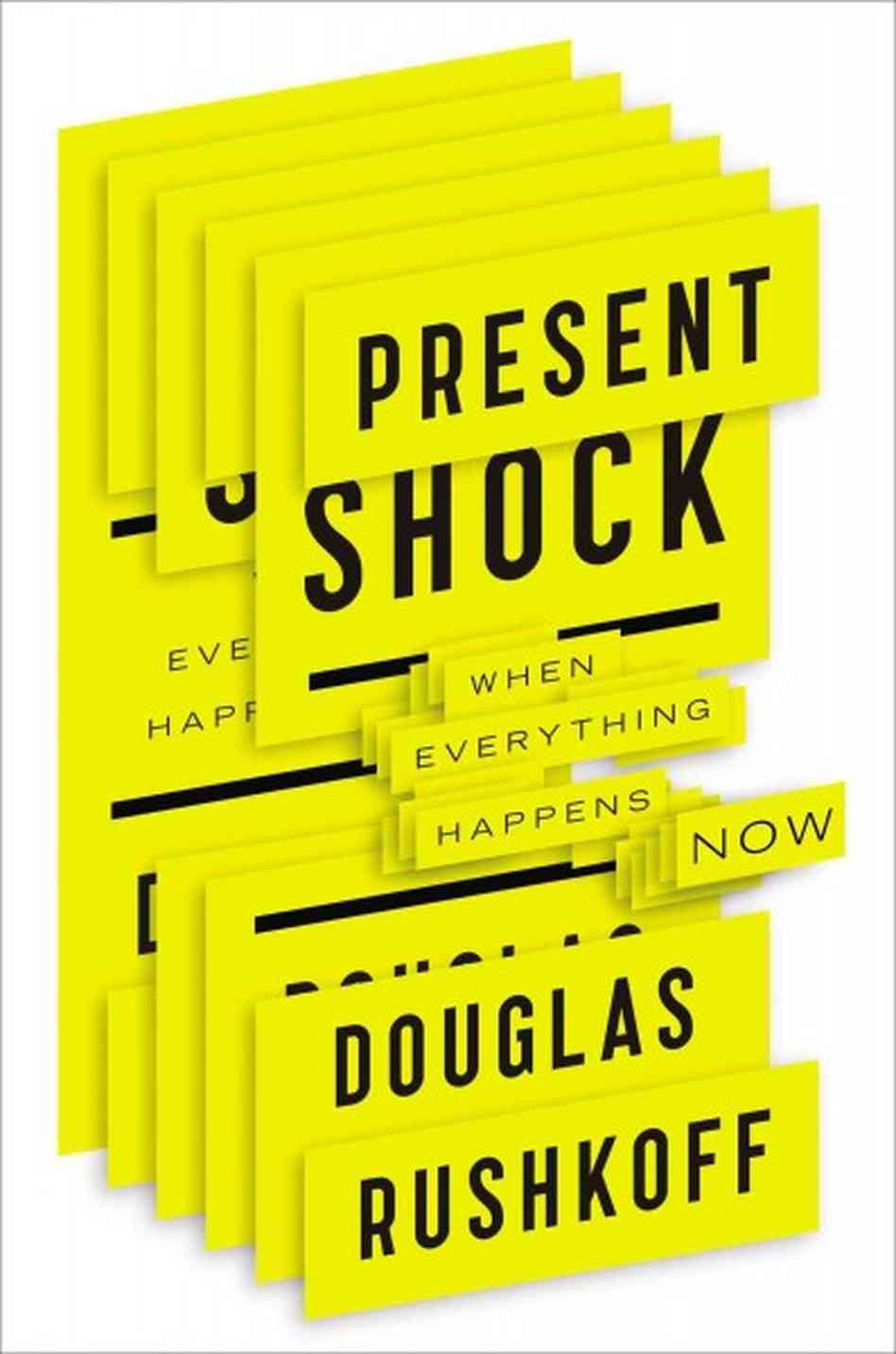“If the end of the twentieth century can be characterised by futurism, the twenty-first can be defined by presentism.”
So begins Present Shock, an intellectual tour de force by renowned media theorist and social futurist Douglas Rushkoff.
Divided into five sections, the wide ranging volume weaves disparate fields of sociology, politics, behavioural economics, culture and technology into a compelling chronicle of humanity.
The Age of the Perpetual “Now”
Instantaneous and always “on”, the digital age is characterised by a perpetual state of “now”.
While the 20th century saw humans casting a hopeful eye towards the future, the 21st century saw a very different world emerging. Ushered in part by the ubiquitous connecting power of smartphones, tablets, and laptops, we are always living in the moment, absorbing and interacting with our world through sound bites.
Our culture is now ruled by a relentless impulsiveness where “narrativity and goals are surrendered to a skewed notion of the real and the immediate; the Tweet; the status update”.
Ambitious and all-encompassing, Present Shock showcases Rushkoff’s considerable prowess in weaving diverse historical events and findings into a coherent hypothesis. Written with much linguistic flourish, it isn’t an easy book to digest and required repeated readings to more fully absorb its key messages.
Let me attempt to summarise Rushkoff’s key premises for you.
Douglas Rushkoff author of “Present Shock” (courtesy of Huffpost Live)
Narrative Collapse
Traditionally, stories took on a linear arc with a beginning, middle and end.
Think of epic poems like the Mahabharata and Homer’s Illiad. We venture along the heroic journeys of heroes like Luke Skywalker, Dora the Explorer or Odysseus from the start to the finish – until the chief villains are slayed or the quest completed.
In the postnarrative world, Homer Simpson has no such journey. Together with other television series that reference pop culture like Family Guy and South Park, The Simpsons took spliced story telling into multiple wormholes, allowing viewers to escape temporally from reality.
This collapse in narrativity is probably best epitomised by CNN, which reports on stories in real-time, moment-to-moment grittiness. Massively Multiplayer Online Role Playing Games (MMORPGs) like World of Warcraft and Guild Wars carry this even further. In those virtual worlds, we’re constantly battling endless foes in fantasy landscapes filled with divergent storylines and discontinuity.
Digiphrenia
The onslaught of digital technologies, particularly smartphones and tablets, have allowed us to consume or produce content while living our lives in an asynchronous fashion. Unfortunately, this has led us to confuse between two main kinds of time: chronos and kairos. The former is time on the clock while the latter means the right or opportune moment.
Because of the time-freezing power of digital technology – you can choose to respond to a Facebook post an hour ago or a week ago – we tend to lose our notion of timeliness. As a result of this, we end up operating in a perpetually reactive (as opposed to reflective) mode and are in danger of being ruled by our devices.
In such an environment, we race to conform to the forced “yes-or-no” choices of machines in classrooms. Here, speed is equated with intelligence.
As Apple has so elegantly stated, using these devices is “akin to taking a bite of the forbidden fruit”. Our digital technologies empower us. However, they simultaneously thwart our efforts to stay truly in the moment or to be full present with each other.
To escape this, we need to become the programmers of our own digital processes rather than be programmed by them.
Overwinding
Labelled “the short forever”, this chapter described how our appreciation of storage and flow changes with present shock.
The old days of local, grain-based currencies which value trading and bartering amongst villagers have given way to a shift to central currencies powered by banks issuing interest-bearing money. As a result of this, we are all spring-loaded to consume more, spend more and do more in order to keep the expansionary economic mill turning.
In the short forever, nothing recedes. Here, everything relative can also be relevant. Nothing, no matter how obscure or remote in a temporal or real sense, is off-limits. With the compression and shifting of time, our expectations for instant reward and gratification has shrunk to almost nothing.
Fortunately, all is not lost.
While we live in an ever present world of Big Data and RAM (Random Access Memory for the un-geeky), some have taken positive steps for the future by working with the community to benefit and contribute to the commons. Hopefully, this spirit of altruistic sharing will trump that of mindless commercial competition.
Fractalnoia
Because “everything is now everything”, we are driven to search for patterns and forms even where none exist. This is best represented by fractals – computer-rendered typologies that attempts to break down natural phenomena into geometrical shapes and lines.
The danger here lies in us trying to draw connections even where there are none. As the saying goes, correlation does not equate causation. Often linkages between seemingly related phenomena are tenuous at best. Thus, we need to be mindful that we do not end up being drawn into a feedback loop that is amplified and connected.
In attempting to manage this chaos, individuals, businesses and governments alike have adopted the tenets of game theory. Every bit of data, feedback and insight is crunched into a predictive model for the future. Beset by fractalnoia, students attempt to skim through pages of a book so that they can “get the gist” of it in compressed time.
To prevent ourselves from falling prey to this paranoia, we are urged to identify and relate what we see and do more holistically. In other words, we should ask ourselves questions such as the following:
- Where were we when we first encountered that?
- What went through our minds the first time we did something?
- How does that occurrence reflect on us?
Apocalypto
Finally, with an ominous and dystopian tone, we now seem to be living in an “apocalyptic” world where viral pandemics, asteroid collisions, terrorist attacks, and other forms of “Armageddon” loom large. In such a landscape, we succumb to a belief in the imminent shift of humanity into a totally different and alien form.
While the human race has yet to be annihilated, this incarnation of present shock has led some to yearn for a “postnarrative future” which belongs to “the godhead, machines, cockroaches, planetary intelligence, complexity, or information itself”.
This impending singularity or second Big Bang shares more in common with religion than its often non-religious advocates would like to admit.
Escaping Present Shock
To escape present shock, Rushkoff advocates that we find the “sweet spot between storage and flow, dipping into different media and activities depending on the circumstances.”
We need to take the time to write or read a whole book (and blog about it :), create safe spaces for uninterrupted thinking, and give each moment the respect that it commands. This also means that we should resist the alluring pull to draw quick conclusions and reject the seemingly inexorable pull of alarmists that the end of humanity is nigh.
For a quick summary of the main ideas (hmm… isn’t that an outcome of present shock too?), do check out this neat infographic below:

Courtesy of LJA Theory of Knowledge 2014


